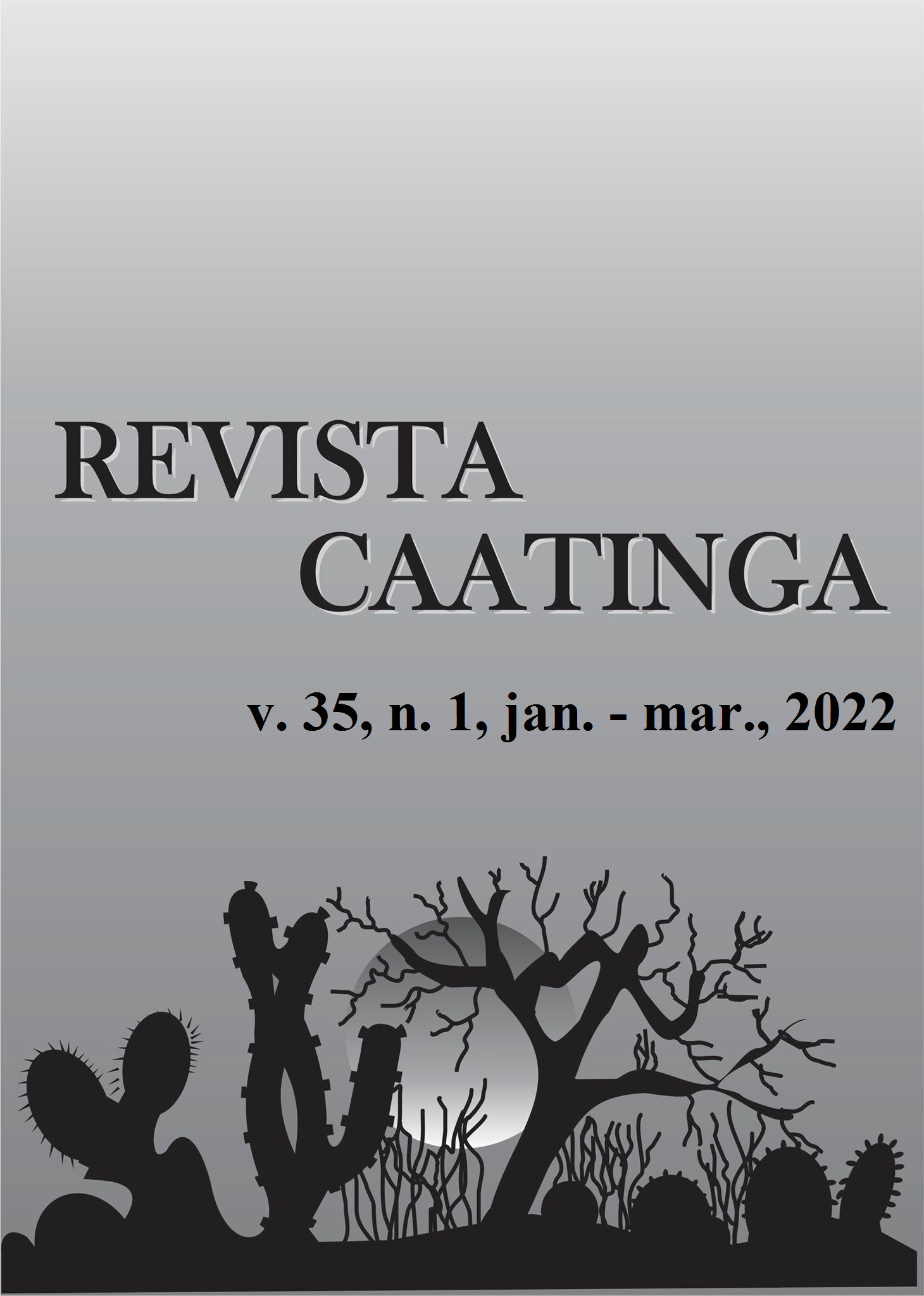NATURAL PARASITISM IN Triozoida limbata (Enderlein, 1918) (HEMIPTERA: TRIOZIDAE) IN A SEMI-ARID REGION OF BRAZIL
DOI:
https://doi.org/10.1590/1983-21252022v35n125rcKeywords:
Biological control. Guava psyllid. Parasitoids. Psyllaephagus trioziphagus.Abstract
For natural enemies to be effectively used in pest control programs, it is important to understand the basic and applied ecology of an agroecosystem, such as guava orchards in semi-arid regions. We identified the parasitoids associated with the guava psyllid, Triozoida limbata (Enderlein 1918) (Hemiptera: Triozidae), as well as the rates of natural parasitism that occur in a semi-arid region of Minas Gerais State, Brazil. About 130 terminal branches with four leaves fully open and with signs and/or presence of the psyllid were collected from a commercial guava orchard and brought to the laboratory. The material was stored under controlled conditions until the parasitoids emerged. The parasitoids were counted and fixed in 70% ethanol for species identification. In total, 9,897 individuals of T. limbata (adults and immature) and 603 parasitoids were found. The primary parasitoid, Psyllaephagus trioziphagus (Howard, 1885) (Hymenoptera: Encyrtidae), was associated with the guava psyllid, with 4.88% parasitism. Secondary parasitoids Signiphora Ashmead, 1880 (Hymenoptera: Signiphoridae), Aprostocetus Westwood, 1833, and Tetrastichus Haliday, 1844 (Hymenoptera: Eulophidae) were also identified.
Downloads
References
BOTI, J. B. et al. Insetos provocadores de danos em folhas, flores e frutos da goiabeira (Psidium guajava L., Myrtaceae) nos pomares conduzidos em sistema de cultivo convencional e orgânico, no município de Santa Teresa-ES. Natureza On Line, 14: 40-44, 2016.
BURCKHARDT, D.; QUEIROZ, D. L. Checklist and comments on the jumping plant-lice (Hemiptera: Psylloidea) from Brazil. Zootaxa, 3571: 26-48, 2012.
COSTA, V. A.; QUEIROZ, D. L.; SILVA, N. A. Psyllaephagus trioziphagus (Hymenoptera: Encyrtidae), parasitoide de Mastigimas anjosi (Hemiptera: Calophyidae). Pesquisa Florestal Brasileira, 35: 339-342, 2015.
DRUMMOND, G. M. et al. Biodiversidade em Minas Gerais: um atlas para sua conservação. 2. ed. Belo Horizonte, MG: Fundação Biodiversitas, 2005. 222 p.
FERNÁNDEZ, F., SHARKEY, M. J. Introducción a los Hymenoptera de la región Neotropical. Bogotá: Sociedad Colombiana de Entomología y a Univerdidad Nacional de Colombia. 2006. 894 p.
GAGIC, V. et al. Agricultural intensification and cereal aphid–parasitoid– hyperparasitoid food webs: network complexity, temporal variability and parasitism rates. Oecologia, 170: 1099-1109, 2012.
HODKINSON, I. D. The biology of Strophingia ericae (Curtis) (Homoptera, Psylloidea) with notes on is primary parasite Tetrastichus actis (Walker) (Hym., Eulophidae). Norsk Ententomologisk Tidsskrift, 20: 337-243, 1973.
MARTINS, F. B. et al. Classificação climática de Köppen e de Thornthwaite para Minas Gerais: Cenário atual e projeções futuras. Revista Brasileira de Climatologia, 14: 129-156, 2018.
MELO, G. A. R.; AGUIAR, A. P.; GARCET-BARRETT, B. R. Hymenoptera Linnaes, 1758. In: RAFAEL, J. A. et al. (Eds.), Insetos do Brasil diversidade e taxonomia. Ribeirão Preto, SP: Holos, 2012. v. 1. cap. 35 p. 553-612.
NOYES, J. S. A review of the genera of Neotropical Encyrtidae (Hymenoptera: Chalcidoidea). Bulletin of the British Museum (Natural History), 41: 107-253, 1980.
NOYES, J. S. Universal Chalcidoidea Database. World Wide Web electronic publication. 2019. Disponível em: <http://www.nhm.ac.uk/chalcidoids>. Acesso em: 12 fev. 2020.
NOYES, J. S.; HANSON, P. Encyrtidae (Hymenoptera: Chalcidoidea) of Costa Rica: The genera and species associated with jumping plantlice (Homoptera: Psylloidea). Bulletin of the British Museum (Natural History), 65: 10-164, 1996.
ROSSI, L. M. et al. Agentes de controle biológico (Arthropoda - Insecta) associados ao cultivo da pinha (Annona squamosa L.). Revista Agro@mbiental On-line, 11: 82-87, 2017.
SÁ, V. A.; FERNANDES, M. G. Himenópteros parasitoides associados a ninfas de Triozoida limbata na cultura da goiabeira, em Ivinhema, MS, Brasil. Ciência Rural, 45: 19-21, 2015b.
SÁ, V. A.; FERNANDES, M. G. Spatial distribution of nymphs of Triozoida limbata Enderlein, 1918 (Hemiptera: Triozidae) in guava orchards. Journal of Agricultural Science, 7: 41-54, 2015a.
SCHAUFF, M. E.; LASALLE, J.; COOTE, L. D. Eulophidae. In: GIBSON, G. A. P.; HUBER, J. T.; WOOLLEY, J. B. (Eds.). Annotated keys to the genera of Nearctic Chalcidoidea (Hymenoptera). Ottawa, ON: NRC Research Press, 1997. v. 1, cap. 10. p. 327-429.
SEMEÃO, A. A. et al. Life tables for the guava psyllid Triozoida limbata in southeastern Brazil. BioControl, 57: 779-788, 2012b.
SEMEÃO, A. A. et al. Seasonal variation of natural mortality factors of the guava psyllid Triozoida limbata. Bulletin of Entomological Research, 102: 719-729, 2012a.
SINGH, S. Description of a new species of Psyllaephagus Ashmead (Hymenoptera: Encyrtidae) parasitizing pit gall forming psyllid Trioza fletcheri (Hemiptera: Psylloidea: Triozidae) on Terminalia arjuna from India. Annales Zoologici, 66: 393-402, 2016.
TAVARES, R. M. et al. Electrostatic spraying in the chemical control of Triozoida limbata (Enderlein) (Hemiptera: Triozidae) in guava trees (Psidium guajava L.). Pest Management Science, 73: 1148-1153, 2016.
WATERSTON, J. On the Chalcidoid parasites of psyllids (Hemiptera, Homoptera). Bulletin of Entomological Research, 13: 41-58, 1922.
WOOLLEY, J. B.; MOLIN, A. D. Taxonomic revision of the flavopalliata species group of Signiphora (Hymenoptera: Signiphoridae). Zootaxa. 4315: 001–150, 2017.
Downloads
Published
Issue
Section
License
Os Autores que publicam na Revista Caatinga concordam com os seguintes termos:
a) Os Autores mantêm os direitos autorais e concedem à revista o direito de primeira publicação, com o trabalho simultaneamente licenciado sob a Licença Creative Commons do tipo atribuição CC-BY, para todo o conteúdo do periódico, exceto onde estiver identificado, que permite o compartilhamento do trabalho com reconhecimento da autoria e publicação inicial nesta revista, sem fins comerciais.
b) Os Autores têm autorização para distribuição não-exclusiva da versão do trabalho publicada nesta revista (ex.: publicar em repositório institucional ou como capítulo de livro), com reconhecimento de autoria e publicação inicial nesta revista.
c) Os Autores têm permissão e são estimulados a publicar e distribuir seu trabalho online (ex.: em repositórios institucionais ou na sua página pessoal) a qualquer ponto antes ou durante o processo editorial, já que isso pode gerar alterações produtivas, bem como aumentar o impacto e a citação do trabalho publicado (Veja O Efeito do Acesso Livre).







